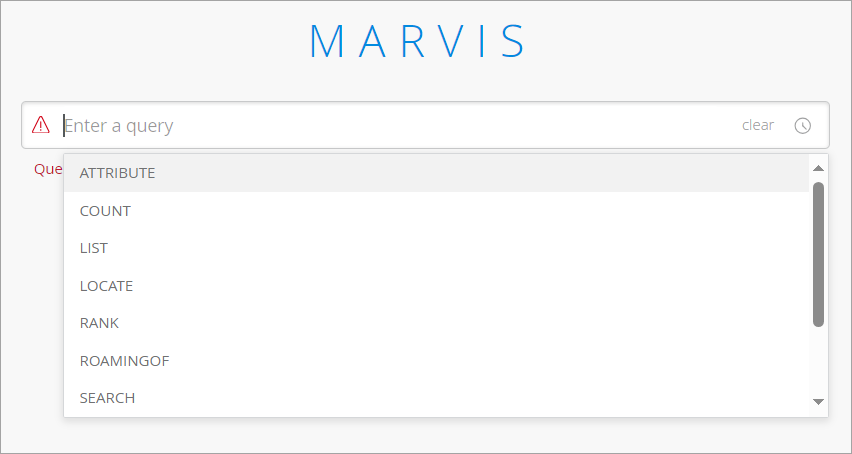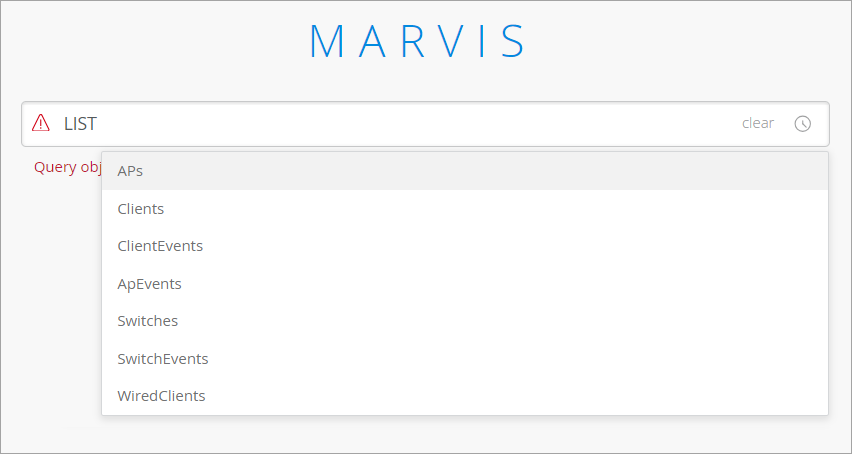In today's product highlights, we are going to cover the query language aspect of
Marvis. With a query language, what you get is a structured format of asking a query
which will result in the raw or the tabular data. This is very powerful when you want to
quickly find out if a certain event or a certain type of failure is actually occurring
in your environment and which all devices are impacted by that.
There are additionally other features as well which we can go through which take us
beyond the simple aspect of searching for a certain event and seeing the impact. So,
let's get started. The one I'm going to walk through today and go through is the list
query.
So, I simply select the option from the drop down, hit my spacebar key and go through
the different options. In our case, I'll go through list client events with, I'll go for
an event type. Say we're interested in DHCP and we're looking for DHCP failures.
So, let's take DHCP denied and we want to see it for a certain WLAN and this is the
only place in the system which you can filter out based on WLAN. So, I'm going to search
on my WLAN call live demo and see what the results are. So, right away we can see there
are 56 such events where the DHCP was denied but all the pertinent information with
respect to which client, what's the one who called that event, the WLAN we already
specified, it's the WLAN live demo do not remove, the IP address it had before or what
it was trying, the AP in terms of the BSSID, protocol, band, channel, so on and so
forth.
You can definitely drill deeper into each event if you click on this option here and
see that this indeed was a DHCP negative acknowledgement, usually seen when the client
is trying to ask for an IP address which is already in use or which is not in that
subnet. Additionally, you can also download this entire list so that you can take it
offline and then slice and dice it based on your requirements. The next piece I'll go
through is with respect to the AP, so I'll clear this out and we'll go back to list.
This time I'll do AP events with AP event type and one of the most popular ones we know
about and we know you care about is APs which are disconnected and that's the one we'll
focus on today. So right here we can see these are the, this is the only AP which is
disconnected but of course you may want to look at it on a more historical time window
and again this is the only place in the system where not only till seven days, you can
also go as far as 30 days worth of data since it's the raw data, be able to present it
to you for a longer time window to see what all went through during that time period.
For our purpose today, I'll just select seven days since most of the times that's a good
window to look at for APs which are disconnected with all the required information of
what the AP is, what site it was at, so on and so forth.
Let's move on to the next use cases of listing and in our case, I'll go for listing
switch events. Again, this is the net new feature in addition to the Wi-Fi based event
querying where you can now get to listing Juniper EX switch events with respect to
whatever is of interest to you. In my case, we'll say with switch event type and I want
to take a look at if there were any significant STP topology changes in my environment
during the last seven days.
Here you can see these are the switches which had their STP topology changed and as
discussed earlier, more details about which the root ID was, what was the root cost, the
port, so on and so forth. This is one such way you can use query language. Again, we
went through the list query looking at the client's access point switches for different
event types.
I highly recommend you go through the other list query options and see what all may be
of use to you further. Additionally, there are other query options as well such as
listing the count of certain entities, ranking them. The one I'm going to focus on and
which is of supreme importance especially in troubleshooting is the roaming off query.
So, I'm going to select roaming off. I can continue using the same site called live
demo or you can select any other site of your choice and I'm going to pick a sample
client such as one of these iPhones here and look at its roaming behavior during the
last seven days. So, right away we can see here all the APs this client was connected to
and then the client's experience in terms of roaming.
Now, why this is crucial is for a number of reasons. One, you get the complete picture
of where all the client has been especially during the trouble ticket time window and
also Marvis highlights and tells you if the roaming was good or bad and if it was bad,
what was the reason it was bad as well. For instance, let's take this one case here
where we do see overall the roaming looks good but let's zoom in into this time window
and see what may have happened.
As an example, we can see here this client was majorly on this EBC AP and for all
purposes its connection was good until it decided to go to this test bed AP where we can
see clearly Marvis highlighting it's a bad room because the RSSI significantly dropped.
Similarly, the client had changed the WLAN or also changed the band. Marvis highlights
it for you so that you don't have to hunt and peck to figure out that was the root cause
of the client experiencing an issue during that time window.
Additionally, for different views of how the client roamed, we have the floor plan
view. As the name suggests, this walks us through where all the client has been so that
we understand if a client did make the correct roaming decision or was it sticking on an
older access point or did it indeed skip access points when it was transisting through
that site. In this case, you can see it started from the GSW AP, pretty much makes its
way to other APs which are in line with its path until we get to the AP where we do see
the issue and you can see here is where Marvis had flagged the issue and if you look at
the AP before it, this AP was far away from the current AP where it had a poor
experience.
So that does give you insights into how the client experienced roaming or how the
client roamed. As we know, roaming is a client decision which AP to connect to, when to
connect to are all client-based decisions. In this case, we can see Marvis highlighted
this since the RSSI drop was significant when it moved to this IDF AP.
And finally, for the raw data analysis, we do provide the tabular view where apart from
it being downloadable, you can also go through the entire journey in terms of the
metrics of the client, everything to do with if it changed the WLAN, the band, and also
the old and new RSSI with respect to the different access points so that you can
directly pinpoint as to the time window when the trouble came in and what the experience
was for the client when it roamed.























